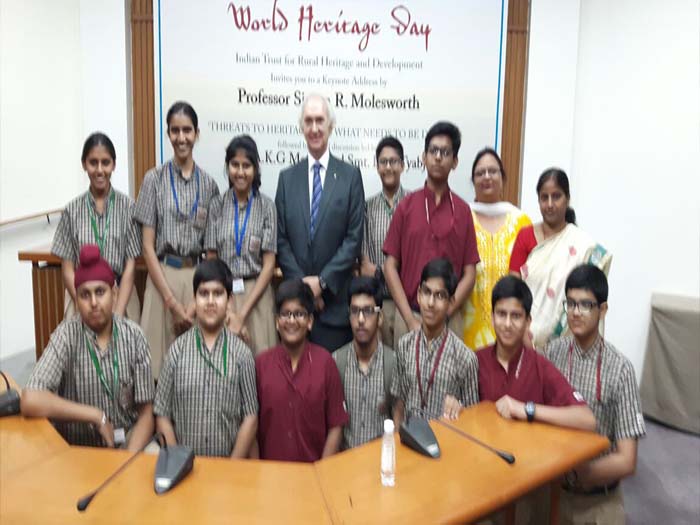Workshop for World Heritage Day
A nations culture resides in the hearts and in the soul of its people.
A workshop cum panel discussion on the preservation of heritage took place on Monday 18th April 2016 at the Indian Habitat Centre. It was organised by the Indian Trust for Rural Heritage and Development (ITRHD). 12 students from our School attended the session. They were accompanied by Ms. Rukmini Thampi and Ms. Nidhi Bhardwaj.
Ms. Sheila Dixit, former chief minister of Delhi, chaired the panel discussion. Professor Simon R. Molesworth, renowned Australian environmentalist, spoke about Threats to Heritage and What Needs to Be Done. This was supported with an effective power point presentation. Mr. Molesworth is the foundation chairman of the executive board of the International National Trusts' Organisation (INTO). He elaborated on the many threats, citing a wide range of examples.
Singapore, a classic example of destroyed heritage, provides an important lesson, he said. In order to develop into a world class city, it destroyed many of its heritage sites. It was only after a sharp drop in the number of tourists that it realised the importance of heritage. So, it rebuilt many of those monuments!
[gallery link="file" columns="2"]
He interestingly summed up the Singapore lesson with the words Never kill the goose that lays the golden eggs, implying ' Do not to get caught by the curse of sameness for the sake of development.
We need sensitive urban planning, sustainability principles and harmonious architecture to protect heritage. He urged people to identify places of cultural importance in order to preserve them. People need to be conscious of the irreplaceability of heritage sites and always remember - Once gone, forever gone.
He pointed out that even compromising the surroundings of a heritage spot is a threat. He explained that while all world heritage sites have legal protection some even have societal or spiritual protection. He claimed that of the 229 natural or mixed cultural sites, 114 are at risk.
Professor Molesworth declared that the disengagement of the local community from protecting heritage sites is one of the biggest threats. For successful heritage conservation, communities should associate a sense of ownership with their heritage. He gave the example of the Great Shu Road, culturally important in China, which was damaged during an earthquake. The local communities rebuilt it very quickly as they all understood its importance.
All communities have a common perspective while preserving heritage: Inter-generational Equity, which implies that all generations have an equal claim to their cultural heritage.
Thanks to pollution, another inevitable threat to heritage is climate change. Indias majestic Taj Mahal is an example. Despite being one of the Seven Wonders of the World, it faces a threat: widespread air pollution is speeding the yellowing of its beautiful marble.
Barbarism is a new and dangerous threat to heritage where extreme groups, such as terrorist organisations, seek to destroy cultural heritage to hurt the sentiments of the people.
Barbarism has its own repercussions which are equally dangerous. For instance, a few months ago, ISIS blew up three ancient tower tombs in Palmyra, continuing its unrelenting destruction of the World Heritage Site. Pictures show flattened earth and rubble at the sites where the 2,000-year-old structures once stood. The whole of Palmyra, including the four cemeteries outside the walls of the ancient city, are listed as a world heritage site by UNESCO since 1980.
Natural disasters are unpredictable and dangerous phenomena which gravely threaten heritage. However, one thing which is predictable is their increasing number, due to climate change.
Professor Molesworth even said that it is not enough to just protect our heritage, we must respect it too.The government should encourage people to retain cultural pride; the aim should be to foster a passion about the potential loss of heritage. After all, people without the knowledge of their past, origin and culture are like trees without roots.
Later, a panel discussion was conducted by Professor A.K.G. Menon and Smt. Laila Tyabji.
Mr. Simmon proposed a massive employment programme to recreate and maintain cultural heritage. Professor Menon added to this by saying that each country must find its own answers for its unique situations. One reason why India has not been fully successful in preserving its heritage is the fact that unlike many others, we own a living heritage. We need to reinvent reasons to conserve heritage and since India is so diverse, it should have its own charter for the preservation of cultural heritage.
The discussion was then opened to the audience. We enthusiastically asked questions, which Professor Simon answered patiently. In fact, when the panel was unable to take up my question due to a shortage of time, Professor Simmons personally came up to me to answer my query.
Smt. Sheila Dixit delivered the vote of thanks. Our School presented a token of appreciation to Professor Simon. We even took a group photograph with the professor and thanked him for the interesting presentation.
We gained not only knowledge, but also a new perspective on the importance, threats and preservation of heritage.
A concerted effort to preserve our heritage is a vital link to our cultural, educational, aesthetic, inspirational, and economic legacies- all of the things that quite literally make us who we are.
Saruby Sharma (XI-B).













